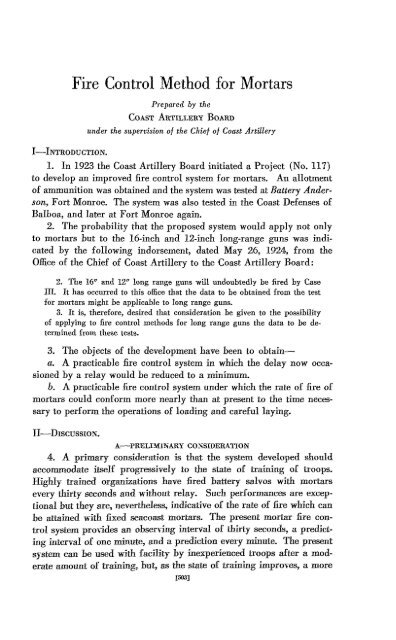COAST ARTILLERY, JOURNAL - Air Defense Artillery
COAST ARTILLERY, JOURNAL - Air Defense Artillery
COAST ARTILLERY, JOURNAL - Air Defense Artillery
Create successful ePaper yourself
Turn your PDF publications into a flip-book with our unique Google optimized e-Paper software.
I-INTRODUCTION.<br />
Fire Control Method for Mortars<br />
Prepared by the<br />
<strong>COAST</strong> <strong>ARTILLERY</strong> BOARD<br />
under the supervision of the Chief of Coast <strong>Artillery</strong><br />
1. In 1923 the Coast <strong>Artillery</strong> Board initiated a Project (No. 117)<br />
to develop an improved fire control system for mortars. An allotment<br />
of ammunition was obtained and the system was tested at Battery Anderson,<br />
Fort Monroe. The system was also tested in the Coast <strong>Defense</strong>s of<br />
Balboa, and later at Fort Monroe again.<br />
2. The probability that the proposed system would apply not only<br />
to mortars but to the 16-inch and 12-inch long-range guns was indicated<br />
by the following indorsement, dated May 26, 1924, from the<br />
Officeof the Chief of Coast <strong>Artillery</strong> to the Coast <strong>Artillery</strong> Board:<br />
2. The 16" and 12" long range guns will undoubtedly be fired by Case<br />
III. It has occurred to this office that the data to be obtained from the test<br />
for mortars might be applicable to long range guns.<br />
3. It is, therefore, desired that consideration be given to the possibility<br />
of applying to fire control methods for long range guns the data to be determined<br />
from these tests.<br />
3. The objects of the development have been to obtaina.<br />
A practicable fire control system in which the delay now occasioned<br />
by a relay would he reduced to a minimum.<br />
b. A practicahle fire control system under which the rate of fire of<br />
mortars could conform more nearly than at present to the time necessary<br />
to perform the operations of loading and careful laying.<br />
II-DISCUSSION.<br />
A-PRELIMI!liARY CONSIDEIVI..TION<br />
4. A primary consideration is that the system developed should<br />
accommodate itself progressively to the state of training of troops.<br />
Highly trained organizations have fired battery salvos with mortars<br />
every thirty seconds and without relay. Such performances are exceptional<br />
hut they are, nevertheless, indicative of the rate of fire which can<br />
he attained with fixed seacoast mortars. The present mortar fire control<br />
system prO\ides an obsen-ing interval of thirty seconds, a predicting<br />
interval of one minute, and a prediction every minute. The present<br />
system can he used with facility by inexperienced troops after a moderate<br />
amount of training, hut, as the state of training improves, a more<br />
[503]
















